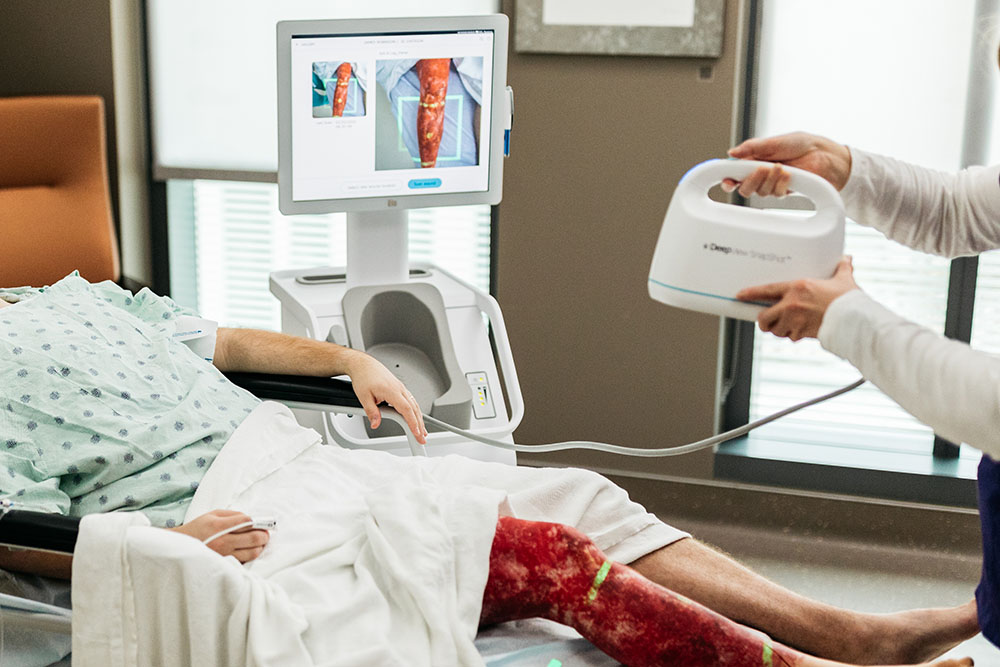Perhaps surprisingly, serious burns remain one of the continuing mysteries of clinical care. Deciding whether surgery is needed is still a matter of guesswork and “waiting to see.” This may not be the case much longer, as there is new technology enhanced by artificial intelligence (AI) that promises to revolutionize burn management. Our VP of Clinical Affairs writes about how Spectral AI is developing a ground-breaking approach to wound healing.
In my long nursing career, I’ve taken care of many burn patients, so I know first-hand the suffering that comes with 2nd- and 3rd-degree burns. That includes the emotional suffering patients must endure from waiting two weeks or more in the hospital to find out whether their burns will require surgery. The ambiguity surrounding burn prognosis – the uncertainty of tissue regeneration – persists as a highly educated guessing game. Burn experts are just 70 percent accurate in assessing the viability of burned tissue, while clinicians without burn expertise can be as low as 50 percent accurate. In addition, the economics of burn management are significant: 40,000 to 50,000 burn patients are admitted to hospitals each year1; 10,000 die of burn-related infections2; and the average cost of treatment per patient is approximately $780,000.
New technology is creating change for burn injury patients
Until now, there has been no realistic push toward developing tools and techniques that can assess burn damage immediately and objectively. Spectral AI’s DeepView® technology promises to provide clinicians a “day one” wound healing assessment that is 92-percent accurate. DeepView’s exceptional capabilities could pave the way for timely and precise assessment of burn wounds, ensuring patients are directed to the most suitable care setting with greater efficiency and accuracy.
How DeepView® changes the equation for burn assessment, diagnosis and evaluation
Spectral AI’s DeepView® technology is a diagnostic platform that combines AI predictive analytics with medical imaging for wound healing predictions. DeepView® proprietary optics can extract millions of multispectral data points from each raw wound image. This information is used to build and continually improve the DeepView® machine learning model. The AI algorithm integrates images from our proprietary clinical database (the world’s largest burn biopsy tissue database) with clinical data to create the most accurate wound healing predictions.
Spectral AI’s DeepView® technology provides an immediate, informed, and binary AI-driven wound healing assessment.
Learn more about the future of burn assessment
By enabling clinicians to transition from anecdotal to objective wound assessment, our DeepView® technology holds the promise of preventing the suffering and uncertainty experienced by burn patients. To learn more about Spectral AI and DeepView®, please contact us. We’re eager to demonstrate the possibilities.
Additional resources:
Mary Regan, Ph.D., serves as VP Clinical Affairs at Spectral AI, where she oversees all clinical trials and supports the commercial business operations. Dr. Regan brings over 30 years of clinical experience in wound technology assessment, development, research, and innovation with major industry leaders. Widely renowned in national and international forums as an industry thought leader in wound care, Dr. Regan’s career has been dedicated to improving prevention and management of chronic wounds and clinical research to improve outcomes for all patients with wounds. Dr. Regan has held board positions in the American Association of Wound Care Specialists and National Wound Healing Society. Dr. Regan received her M.S./B.S. degrees in Registered Nursing, Nursing Administration, Nursing Research, and Clinical Nursing from SUNY Upstate Medical University and her Ph.D. in Nursing Science from the University of Miami.
References
- Burn Care Centers Market Analysis and Segment Forecast to 2030 115 V0.1 ©Grand View Research, Inc., USA. All Rights Reserved
- https://ameriburn.org/resources/burn-incidence-fact-sheet/
- https://pubmed.ncbi.nlm.nih.gov/26508532/
- https://www.physio-pedia.com/Assessment_of_Burns
- https://pubmed.ncbi.nlm.nih.gov/30595543/
- https://www.medicaltranscriptionservicecompany.com/blog/medical-documentation-burn-injuries/
- https://www.physio-pedia.com/Assessment_of_Burns
- https://www.ncbi.nlm.nih.gov/books/NBK513287/
- https://pubmed.ncbi.nlm.nih.gov/30020659/





